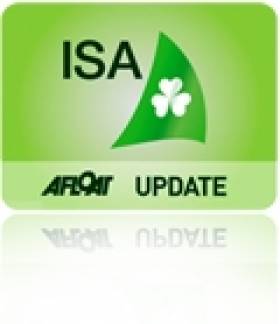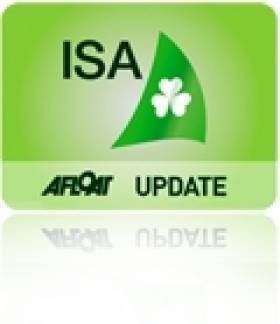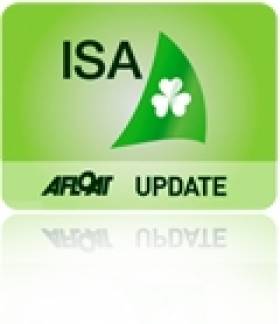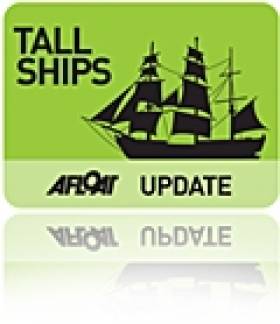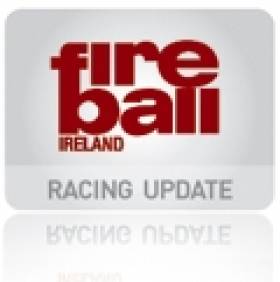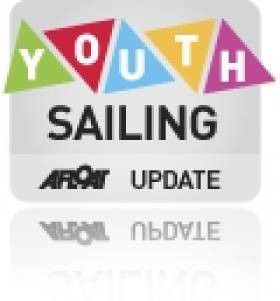Displaying items by tag: ISA
It's Not All Doom And Gloom For Irish Dinghy Sailing
#Dinghy - The big discussion on the fate of small boat sailing will have to wait another few weeks, with the deferment of the Irish Sailing Association's (ISA) Dinghy & One Design Keelboats Convention till 30 November at the earliest.
But the delay will be worth it if it means getting all the key figures in place for these necessary talks on plotting a new course for small boat sailing in Ireland.
It's undoubtedly a big task, attested by the highly charged classes forum in March this year that produced more than 300 suggestions for changes in the way the ISA handles small boat sailing.
That forum, which itself followed some intense discussion on Afloat.ie, prompted the ISA to publish a number of recommendations - among them its conclusion that the move away from using the voluntary support of small boat sailing clubs towards a stricter organisational regimen in the 1998 strategic plan has been significant in the "perceived disengagement of the membership from the operations of the ISA".
In the wake of those recommendations, Dublin-based sportboat sailor Ric Morris contributed his own list of things the ISA could do to rejuvenate Irish dinghy sailing.
Among them was the formation of an 'Irish Dinghy Racing Association' that would ensure smaller club's interests aren't dwarfed by the bigger, elite sailing classes; making club fleet sailing - and club class captains - the heart of every club; and even offering group purchasing schemes to lower the cost of both entry to the sport and sustaining club sailing.
Cost is indeed a major issue, as events administrated by national bodies cost money - more than what many are willing to pay, as the fall in participation levels demonstrates, according to former ISA president Roger Bannon, who also points out creeping costs even outside of the big competitions, from new recruits being persuaded to purchase expensive new boats when second-hand vessels would do, and the expense in acquiring instructor qualifications at club level.
On top of that is what Bannon perceives as a blinkered focus on single-handed classes with elite-level potential like the Laser and Optimist "almost to the exclusion of multi-crewed alternatives" which has had the result "of not equipping youngsters with the basic skills of sailing in a team environment" - a contrast to Britain, where the RYA throws big support behind economical classes like the Topper and Mirror.
Bannon followed up those thoughts more recently with figures from the last two years of class championships for dinghies and keelboats, which for him show that the small boat sailing scene in Ireland "is clearly on its knees".
Yet even for strong critics of the handling of Irish dinghy sailing, there's some good news to savour.
Looking at the figures for 2013 provided to him by Roger Bannon, Ric Morris points out that the RS400 and multihulls "now reach the standard suggested for a National Class" while RS200 numbers are on the rise, and GP14s have had a "bumper year with 50 boats at their nationals" and a Worlds event on Strangford Lough in August 2014.
The new Moth Class, which sees its Irish Open in Howth this weekend, also spells good fortune for small boat sailing in a country where adult dinghies make up 32% of all boats and nearly half of all sailors competing in small boat title events.
And youth sailing is taking up the slack, with 68 boats - the majority of them Irish - fielding at the Mirror Worlds on Lough Derg.
All of this must of course be seen in light of the decline in day boats, says Morris, from the SB20, which "no longer has a club presence outside of Dublin Bay", to the Flying Fifteen, with only one club fleet in Ireland, while the Etchells "look to have died altogether".
However, it can't be ignored that the first two of these classes at least still have healthy traveler series, and the Flying Fifteen was represented by an impressive 30 boats at the class Nationals this year.
What nearly everyone agrees on is as Norman Lee comments: that the long-term decline in numbers is undeniable and must be reversed. And the key to that may well be putting sailing back in the hands of sailors, not bureaucracy.
There's sense to the notion that top-down management of sailing classes ensures consistency in training and abilities to help develop elite-ready competitors, but perhaps some types of sailing were never meant to be handled that way.
As Ric Morris comments again, we shouldn't "expect to create world class sailors from the domestic small boat environment. That's the High Performance team's problem.
"The idea of producing elite sailors from the domestic sailing scene was killed off in the mid '90s," he adds. "Elite sailors now come from sailing against other prospective elite sailors. That's a good thing. It means there should be no pretense over what needs to be done."
What's your take on the situation? Share your thoughts in the comments below.
ISA Defers Dinghy Sailing Meeting at National Yacht Club
#dinghy – The Irish Sailing Association (ISA) has deferred its important conference on small boat sailing at the 11th hour. Scheduled for this Saturday the 'Dinghy & One Design keel-boat Convention' was due to examine problems in the sport will not now tkae place til November 30.
Citing the unavoidable absence of some key representatives the Advisory Group, the ISA says it has taken a decision to defer the meeting until the 30th of November.
As recently as this week a former ISA president wiritng on Afloat.ie set out the big task ahead to put small boat sailing back on an even keel. Roger Bannon gathered two years of championship information to put before the meeting but drew the conclusion that the 'scope of the task was awesome'.
This month's meeting follows a higly charged 'classes forum' held last March which produced over 300 suggestions for change in the way the ISA handles small boat sailing.
That meeting also prompted Ric Morris' suggestions for five things the ISA could do to rejuvenate dinghy sailing in Ireland. His salient points will surely provide much fodder for discussion on the day.
ISA Hosts Convention To Discuss Dinghy Racing's Future
#ISA - The Irish Sailing Association has issued an open invitation to dinghy sailors to discuss the future of dinghy and one design racing in Ireland at a special meeting less than two weeks away.
The Dinghy & One Design Keelboats Convention will take place on Saturday 2 November at 10.15am in the JB Room at the National Yacht Club in Dun Laoghaire.
Chaired by Margaret O'Donnell, the convention follows on from the classes forum this past March, which led the ISA Board to establish a Dinghy/One Design Racing Advisory Group.
That meeting also prompted Ric Morris' suggestions for five things the ISA could do to rejuvenate dinghy sailing in Ireland. His salient points will surely provide much fodder for discussion on the day.
New Sailing Tracker App 'Will Save Many Lives'
#Apps - A new smartphone app developed by the Irish Sailing Association (ISA) that aims to make it easy for boaters to allow contacts on shore to monitor their voyages has been launched today (Thursday 22 August).
Marine Minister Simon Coveney was on hand in Cork for the official unveiling of ISA SafeTrx, which was developed in association with the Irish Coast Guard and DeCare Systems Ireland.
The SafeTrx app is available free for iOS and Android powered smartphones and tablets, and lets boat owners log their voyages directly into their device - allowing them to be tracked by their chosen contacts, including the Irish Coast Guard.
It's also expected that the app will also help the coastguard to identify the location of a stricken vessel, and assess details such as craft description, contact details ashore, previous activity, where the boat was last visible to the network and where headed, persons on board and other information - all targeted at reducing the time that seafarers spend in the water waiting for a lifeboat or helicopter.
“SafeTrx helps take the search out of search and rescue," said Irish Coast Guard director Chris Reynolds. "It encourages all sea users to plan and execute their trips better, safer and gives assurance to friends and partners ashore.”
His comments were echoed by ISA chief executive Harry Hermon, who said: "I believe that ISA SafeTrx, which has been designed by coastguard professionals and built right here in Cork, will help to reduce the number of fatalities on the water even further. I have no doubt that this will save many lives."
Also speaking at the launch today, Minister Coveney said: “The concept of safety at sea and on our network of rivers and lakes must become as commonplace as that of safety on our roads. We need to create a culture of safety first for those travelling on our waters for either commercial or recreational reasons.
"With loss of life continuing across the maritime spectrum, those who make their living from the sea and those who utilise the sea primarily for leisure purposes must ensure that safety becomes a top priority.”
ISA SafeTrx logs position reports every kilometre (or every 5 minutes if stationary). Should the user fail to return on time, their emergency contacts will be automatically alerted via SMS and advised to initiate the appropriate action.
Voyage position reports are displayed on the SafeTrx Monitoring Console so when an emergency contact calls the Irish Coast Guard concerning an overdue trip, coastguard staff will have access to the user’s location and SafeTrx trip data through a secure SafeTrx server. And as the ISA SafeTrx app periodically sends location data back to the servers, the coastguard's response team can get help directly and quickly.
However, an expert in GPS technology has warned boat users against relying solely on such apps when heading out on the water.
Writing for Afloat.ie's Have Your Say blog, Gary Delaney of Global Position Intelligence (GPI) says the GSM and GPRS location technology on which the SafeTrx app is based is "less than reliable" in Irish coastal and nearshore waters, and "can deteriorate with the weather".
"It is well recognised that in the event of a maritime emergency, lifesaving agencies need to know the current position of the casualty as quickly as possible," he writes. "An assessment of available technologies reveals that only normally approved safety communications devices, such as marine VHF, AIS, EPIRBs, PLBs, ELT, etc can come near guaranteeing that requirement."
The app developers have acknowledged such concerns, saying that ISA SafeTrx is "not intended to be used as a replacement for statutorily recognised safety devices" but is "a resource that in some instances may help to raise an alarm earlier and assist emergency services to locate casualties more accurately".
As always, Afloat.ie advises boaters and sailors to stick to a standard safety checklist, which includes informing a contact on shore of your plans and expected return time, and confirming that you have adequate means for calling for help - from a suitable VHF radio to flares for signalling distress.
Four RNLI Lifeboats Rescue Crew From Sunken Tall Ship Astrid
#TallShips - Four RNLI lifeboats were involved in the rescue of 30 crew from the tall ship Astrid, which sank off the Cork coast earlier today (Wednesday 24 July).
The 42m Dutch training vessel reportedly hit rocks inside the Sovereign Islands at Ballymacus Point, near Kinsale.
All on board were brought to safety when the Kinsale lifeboat transferred the casualties from the sinking ship onto the Courtmacsherry RNLI lifeboat and a local vessel. They were then taken to Kinsale.
Both Kinsale and Courtmacsherry RNLI lifeboats were called out at 12 noon today to go to the immediate aid of the sail training vessel that had got into difficulties on the western entrance to Kinsale Harbour in Cork.
Ballycotton and Crosshaven RNLI were also launched, though the Kinsale RNLI lifeboat was first on scene. There was a 2m swell and winds were force five to six.
The training vessel had lost power and was apparently driven on to rocks by a strong southerly wind at the western entrance to Kinsale Harbour. The grounded vessel was taking on water and a crewmember from Kinsale RNLI was put onboard.
Eighteen of the casualties were taken off the Astrid by Kinsale RNLI lifeboat and transferred to Courtmacsherry lifeboa, before being brought to safety. The remaining 12 were put onto a liferaft deployed by the Astrid’s crew, which was towed to safety by the Kinsale lifeboat and picked up by a local vessel.
The people on board the liferaft were then taken to Kinsale harbour and assessed by medical teams.
Irish Coast Guard helicopters from Waterford and Shannon were also on scene along with ambulances and medical crews from Cork.
Speaking about the call-out, Courtmacsherry RNLI coxswain Sean O’Farrell said: “Everyone was very fortunate. I want to praise the quick thinking of the skipper and the crew from the Astrid. They kept calm and did everything we asked them to do. We were able to get them to safety quickly and a major tragedy was averted. To be able to recover 30 people safely was a great day for everyone involved.”
Meanwhile, the Irish Sailing Association has issued the following media statement on behalf of the tall ship Astrid:
Tall Ship Astrid was on a voyage from Southampton to Cherbourg calling in to Kinsale. On board were 23 trainees from France, Ireland, the Netherlands, UK and Spain. The crew were from Belgium and the captain, Pieter de Kam was from the Netherlands.
As the Astrid was leaving Oysterhaven, as part of The Gathering Cruise parade of sail to Kinsale, the vessel experienced engine failure. They notified a nearby RIB which was being helmed by Irish Sailing Association (ISA) CEO Harry Hermon.
The RIB attempted to take a line from Astrid. However, due to the onshore winds and swell this was not possible. Captain de Kam issued a May Day.
The ISA RIB and the yachts in The Gathering Cruise flotilla stood by until the RNLI arrived. There was a safe rescue of all 30 crew who were brought to Kinsale on board the yacht Spirit of Oysterhaven and the lifeboat. All crew were brought to Kinsale Yacht Club where they were provided with showers, food and dry clothing. They were all medically checked and are in good health.
Sail Training Ireland and Kinsale Yacht Club are working together to make arrangements for accommodation and for returning the crew to their homes.
Commenting on the rescue, Captain Pieter de Kam of the Tall Ship Astrid stated: “I would like to thank the lifeboat and the coastguard for the safe rescue of all my crew. We very much appreciate their outstanding work.”
Harry Hermon, CEO of the Irish Sailing Association, commented: “It is thanks to the rescue services that all crew were rescued quickly and safely without injury. I would also like to thank all the sailors from the Gathering Cruise who stood by Astrid providing support to the crew.
"Kinsale Yacht Club has also been fantastic providing food and clothing and helping Sail Training Ireland find accommodation for all the crew”.
Fireball Coaching Does Not Qualify Under ISA Grant Rules
Specialist coaching for The Irish Fireball Class Association is not covered in the Irish Sailing Association's new coaching scheme for non-Olympic classes accoording to the latest Fireball class newsletter. One of the biggest dinghy classes in the country has investigated the new scheme but reports the ISA coaching monies are available only if 'ISA approved coaches are used'.
The news letter goes on to say: 'They [The ISA] have proposed to make some monies available for coaching in non-Olympic Classes, but on further investigation the coaching would have to be provided by ISA approved and registered coaches. Thus, for example, the coaching that we as a Class provide to our own members would not qualify for financial support under this scheme. Likewise, the Adam Bowers training session would have to be funded from our own resources.
The new coaching arrangements were put in place after a motion placed before the AGM of the ISA by Bryan Armstrong (Sligo Yacht Club) and Norman Lee (Greystones SC) sought far reaching reforms of the Association. A meeting held after the agm produced 300 proposals for change inlcuding increased coaching for senior dinghy fleets.
Five Things The ISA Can Do To Rejuvenate Irish Dinghy Sailing
#isa – In the wake of today's ISA recommendations for small boat sailing, Ric Morris suggests his own and they include a rekindled dinghy racing association as one of five solutions to the decline in Irish small boat sailing:
1/ Form an Irish Dinghy Racing Association (IDRA)
Outside of direct government funding, including funding for the high performance program and associated HP youth pathway, the ISA is predominantly funded by what amounts to a flat rate tax on club membership. The good thing is that this secures enough funding and gravitas for the ISA to represent the sport at a legal and legislative level and it gives every member of a club automatic access to the benefits of ISA membership. The bad thing, from a dinghy perspective, is that it also means that ISA thinking is dominated by the 7–8 clubs whose size means their contribution is by far the greatest. These clubs also tend to be the clubs predominantly involved with keelboat and yacht racing.
With very few genuine national classes at present and problems accessing venues for classes with small, or even relatively healthy, fleets there is a lot to be gained from pooling resources. As seen with the recent addition of the Moth to some of the Fireball traveller events with suitable co-ordination events can be shared. The RS class is another example of how classes can combine to advantage, as historically have the Jack Holt boats.
A lot of what's needed could be done without the formation of an IDRA but a forum is clearly needed at least for the time being. I highlighted some of the good things going on above but it shouldn't be left to 'knowing someone who knows someone'. Don't get me wrong but the dinghy classes have a lot to prove in terms of working together. Some classes, ironically the ones left standing, don't have a great track record of working well with others. To take a place at the ISA table the dinghy classes, and the clubs whose primary activity is dinghy racing, need to combine and show that they are capable of putting forward a well-supported and co-ordinated agenda.
2/ Provide clearer guidance on the health of the clubs and classes
If you are looking to get involved in dinghy racing in Ireland there's next to no information on the health of dinghy racing in Ireland and no information on which classes offer the best prospect in terms of healthy local and national sailing. Any class that's organised enough to muster up the €150 annual fee can join the list of ISA affiliated classes. The needs of classes in different stages of development are different too and having a clear understanding of where each class is can only help focus attention on where development is needed and support should be given.
The way classes come and go in terms of volunteer strength and equipment improves as time goes on means that, as well as being next to impossible from a practical perspective, it's not appropriate to look to dictate equipment at a national level. Sailors and clubs will choose what they believe is best and room for new classes needs to be allowed or there is a risk of exclusion. To balance all of the above the ISA should distinguish between the following categories of class with in its affiliation. There is nothing to force a class to reach a given standard but the ISA should offer support to classes based on them having reached a certain level of organisation.
National Class
A national class should have:
· A class builder or dealer in Ireland.
· A National Championship in the last 3 years with 20 Irish boats or more than 15 Irish boats in each of the last 3 years with publicly available results via the web.
· Their National Championship run by a nationally or internationally qualified Race Officer and Jury Chair.
· Club fleets in more than one province. Average of 5 or more finishers in racing with results published on the web.
· A traveller series with events in more than 2 provinces a year.
That's quite a tough ask but it's also a reasonable list in terms of what a dinghy class needs to do in order to establish itself.
Historic Class
A historic class should have:
· An historic national or local significance.
· Strong local support in at least 1 location
Local Class
A local class should have:
· Strong local support in at least 1 location. Average of 5 or more finishers in racing with results published on the web.
To be honest if a class can't satisfy this then should they be recognised by the ISA as a class?
Current classes
Using these criteria currently the adult classes would break down as follows:
National classes:
Dinghy: Laser, GP14 and Fireball
Keelboat: ICRA Class 1, 2, 3, SB20 and Squib, plus potentially the Dragon
Historic classes:
Dinghy: IDRA14, SOD, Water Wag, Mermaid and National 18.
Keelboat: Howth 17, Glen and 1720.
Local classes:
Dinghy: Multihull, RS400, RS200, Drascomb Drabber, 505 and Wayfarer.
Keelboat: J109, 31.7, Flying Fifteen, E-Boat, Etchells, Puppeteer, Ruffian, Shipman and Sigma 33.
The same thing should be done for the clubs. Coming from outside the sport would you know where the strongest dinghy clubs are? Skerries, Malahide, Monkstown, Killaloe and so on.
3/ Build a national database of sailors passing through the ISA training scheme
There are only so many experienced sailors in the country and inevitably they leave the sport for personal reasons all the time, only some too return later. A large number of those are event focused and move from class to class based on which is currently running a major event. Arguably the senior graduates from the HP pathway feed directly into this group too, those that aren't emigrating. To grow a class the primary focus needs to be on grass roots sailors buying a boat for the long term and in this respect a young sailor continuing in the sport as an owner of a dinghy is better than one continuing as a crew of a cruiser racer.
With a deservedly well-funded high performance program an HP youth pathway is a fact of life. It takes in a large number of kids and spits out nearly all of them along the way. For a while they live the dream but what happens after that?
We tend to think only about the issues we see in our sport, but in fact the same issues seem to occur in youth sport as a whole. Internationally by age 16 two thirds of kids have given up competitive sports like football and rugby for non-competitive sports like surfing and kite surfing. Team sports buck the trend better than individual sports. That would support the case for double handed classes for kids not continuing on to Olympic glory but not that for including racing and log books earlier in the pathway.
If you leave kids in the pathway until the end the figures don't look great. 80% drop out at the point the purchase of a boat is required and a further 12-13% are gone by the time they reach leaving cert age. I would argue that an effort is needed to get kids who can't afford a boat of their own into crewing in adult classes and into adult classes in general as soon as they are physically able. Why? Adult classes provides a continual involvement in sailing the stretches beyond the 2-4 years a child will typically spend in a single youth class. The clubs boats typically used for training provide a means to an end and allow training centres to cater for the large numbers of people interested in giving sailing a go but they are next to useless in terms of delivering a fulfilling on the water experience thereafter.
While not enough is being done to capture the interest of those falling out the HP youth pathway, either to transition kids into more suitable classes or into adult classes there is also an issue of parental expectation. In terms of the long run a sailor may be better off in an adult class as soon as they are physically able but in the short term the adult classes need to address the level of additional activity and support that sailors get corralled into a junior class. All those parents add up to considerable additional volunteer effort. To be successful in taking young sailors from the HP pathway clubs and adult classes need to welcome the parents and give them a positive role.
In reality these are issues for the clubs and classes to address themselves but the ISA can help greatly by providing some glue. A national database of people coming through the training programmes would provide the clubs and classes with an invaluable list of people to contact when they are running open or try/buy days.
4/ Spread club class captain best practice
The old adage that club fleets make classes and class captains make club fleets still holds true.
Why are club fleets so important? Most dinghy racing isn't done at traveller event or national championships it's done out of sight on weekday evenings and weekend afternoons. Club fleets provide the essential support for people looking to enter the sport, even more so for new boat owners. Club fleets provide:
· Time efficient and easy access to the water when being on the water, rather than quality of racing, is the priority.
· Advice on boat ownership
· Help and advice with maintenance
· A standard of racing that is accessible for new sailors
· A sense of local community
At the heart of every thriving club fleet is an energetic class captain. It's a hard job, volunteers are thin on the ground and too often a new class captain has to learn on the job. In the time it takes to get up to speed fleets can die.
There are a number of eminently successful fleet builders in the country, some with experience managing international class associations. Their knowledge needs spreading so that every class captain in the country knows what's required to build build build and where one person doesn't have the time or resources to do what's needed then the work can be shared rather than go undone. As a central body the ISA is well placed to pull together and share best practice, offer training as it does with race management or rules or even set up a mentoring scheme.
5/ Offer a sail and boat group purchasing scheme for national classes
Classes can survive for a long time on second hand boats and UK imports by single owners but if a class is to grow in the way need to rejuvenate dinghy sailing in Ireland then new boats are required, not only to increase the fleet size but to trickle down boats so that good second hand boats are available for people looking to enter the sport. The issue is that, for example, a new GP14 with sails and trailer currently costs in excess of 10k, a Fireball double that and to building a new boat for one of the historic classes above 20k is the starting point. That 20k will buy you a fleet of 8 refurbished Fireflys with change shows the potential power of group purchasing. The SB20 fleet is another example of what can happen when a solid fleet purchasing scheme is in place.
At present the dinghy scene is, perhaps, too fragmented to co-ordinate such an effort. The ISA has shown with the SailFleet scheme that it has the ability to do a deal and in the current economic climate the national governing body is potentially the only route for securing capital support for such a scheme. A similar scheme could easily be arrange for the purchase of sails. Such an effort should be focused on the national classes, as defined above, which have the basic essential infrastructure already in place to sustain dinghy racing at a national level.
Develop the class captains of local classes to enable them to build up their class to national standard and then support the national classes to get boats into people's hands.
#isa –The ISA President Niamh McCutcheon says the association's decision in 1998 to move away from utilising voluntary support has been a significant factor in the 'perceived disengagement of the membership from the operations of the ISA'. The conclusion is contained in ISA Board recommendations from March's Dinghy Sailing Forum published today (download the full recommendations as a pdf below).
The 1998 strategic plan was, however, unanimously approved by the membership and in its foreword the then president Neil Murphy expressly referred to the association's requirement for volunteer involvement 'whose contribution was crucial to the success of the ISA'. (PDF of the 1998 strategic plan foreword is downloadable below).
Today's recommendations follow the motion proposed by Norman Lee and Bryan Armstrong at the ISA AGM held on 2nd March. Following intense discussion on Afloat.ie a meeting was called to discuss the future of Small Boat Sailing and Youth training in Ireland. This meeting was held in the National Yacht Club on 23rd March.
The President says in her recommendations there are a number of action items that may help in the short term but there is no simple solution. 'The implementation of changes to the strategies and structure of an organisation such as the ISA will evolve in time, and only with the help and support of clubs, classes and training centres'.
The March forum was chaired by former ISA President Paddy Maguire, and heard strong views from another former president Roger Bannon. Over 120 (including 14 ISA Board and staff members) were present, representative mainly from the Dublin area from a wide range of Small Boat Sailing interests - clubs, training centres & classes.
Comment on this topic is welcome below
Afloat.ie Boosts Readership with 'Shake-Up of Sailing' Debate
#sailing – What started out as calls for change in Irish sailing on Afloat.ie a month ago has this week been echoed around the internet with more than a little worldwide momentum.
A boost in unique visitor traffic to Afloat.ie could not be more heartening with quality inbound links to an online debate on stemming the decline of dinghy sailing.
Over the course of a month from February 26th 12 separate stories on the topic generated over 11, 000 readers.
The message is very clear. Grassroots sailing needs to be revitalised and if this is energised correctly the general improvement in standards will produce world class sailors.
In early March, thanks to the efforts of a group of passionate dinghy sailors concerned over the lack of recognition for senior dinghy fleets by the Irish Sailing Association (ISA) has grown internationally to highlight some serious deficiencies in the management of the most exciting sport in the world, yacht racing.
A full 'shake–up' for Irish sailing is now on the agenda for 2013 after dinghy champions took aim at current policies they claimed are 'damaging the sport'.
The meaningful online discussion on Afloat.ie was heartfelt. The constructive comments from sailors at home and abroad will be important for the future direction of the sport.
Now it is hugely supportive to see former world sailing president Paul Henderson adding to the chorus that calls for a renewed emphasis on dinghy sailing and encouraging a broader base of participation in the sport.
Henderson correctly focuses on kids being ignored who may never be Olympic helmsmen but still want to get out on the water crewing.
It is also interesting that some notable leading yachting publications have so far studiously ignored the debate despite being well aware of it, this is probably more a sign of vested interests!
But all that is changing now the likes of Henderson has shared his thoughts on the elements that grew the sport of sailing over the past four decades, and what he believes is holding sailing back today it is clear change at home and abroad is well overdue.
Aside from the expense of new boats and the emphasis on single-handers and college sailing that prioritises the most elite athletes, the Canadian sailing hand also believes yacht clubs in North America "have forgotten what they are about... [thinking that] regattas should be a profit centre, rather than the hosting the sailors cheaply as the raison d'etre of a yacht club."
These comments come after former ISA president Roger Bannon's candid assessment of the state of sailing in Ireland today.
According to Bannon, the "importance of supporting elite and Olympic sailing" must become "a subsidiary focus to the main objective of getting people sailing competently and safely in whatever boat they wish".
The ISA today is finalising the recommendations of its board meeting held last night. Its Chief Executive has promised to effect change and wants a closer working relationship between the clubs and classes.
Voices Across The Pond Call For Sailing Growth
#Sailing - Scuttlebutt Sailing News has highlighted some North American voices adding to the chorus that calls for a renewed emphasis on dinghy sailing and encouraging a broader base of participation in the sport.
Former ISAF president Paul Henderson shared his thoughts on the elements that grew the sport of sailing over the past four decades, and what he believes is holding sailing back today.
Aside from the expense of new boats and the emphasis on single-handers and college sailing that prioritises the most elite athletes, the Canadian sailing hand also believes yacht clubs in North America "have forgotten what they are about... [thinking that] regattas should be a profit centre, rather than the hosting the sailors cheaply as the raison d’etre of a yacht club."
Meanwhile, US Sailing president Tom Hubbell has added his own suggestions for introducing young newcomers to the sport through the one-design classes - via mentoring, networking socially and, very importantly, limiting failure so that young sailors will be encouraged to return again and again for more.
Their comments come after former ISA president Roger Bannon's candid assessment of the state of sailing in Ireland today.
According to Bannon, the "importance of supporting elite and Olympic sailing" must become "a subsidiary focus to the main objective of getting people sailing competently and safely in whatever boat they wish".





























